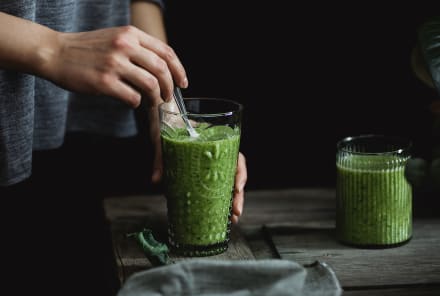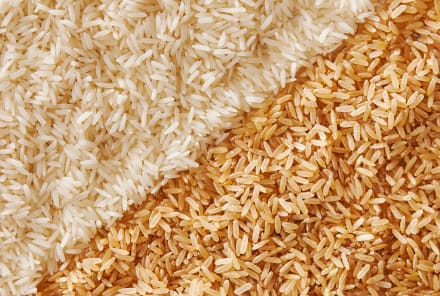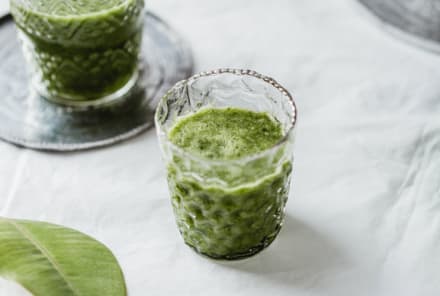Advertisement
7 Benefits of Spirulina: The Blue-Green Algae Superfood Supplement


You may have heard some hype around sea vegetables lately—and for good reason. These unique veggies pack all kinds of nutritious benefits that are worth noting.
While kelp and seaweed may be the first types that come to mind, spirulina is a non-seaweed, single-cell algae that also falls into this category. Spirulina is a type of bacteria called cyanobacterium, which is often referred to as blue-green algae, and it is a bona fide superfood. These algae contain antioxidants, vitamins, minerals, and other nutrients and have been used as a food supplement for years.
Here's what you need to know about spirulina, its benefits, and how to use it.
The benefits of spirulina.
Spirulina was originally classified as a plant but has since been reclassified1 as bacteria. There are a number of spirulina species, but three are the most studied1 as nutritional supplements and possible therapeutic remedies: Spirulina platensis (Arthrospira platensis), Spirulina maxima (Arthrospira maxima), and Spirulina fusiformis (Arthrospira fusiformis).
1. It's packed with vitamins and minerals.
So what makes spirulina so great from a nutrition standpoint? Well, first of all, it contains high levels of many nutrients, including calcium, potassium, B vitamins, and iron. Here’s the nutritional breakdown for a single tablespoon of spirulina2:
- 4 grams of protein
- 11% of the recommended dietary allowance (RDA) of vitamin B1 (thiamin)
- 15% of the RDA of vitamin B2 (riboflavin)
- 4% of the RDA of vitamin B3 (niacin)
- 21% of the RDA of copper
- 11% of the RDA of iron
In addition to all of that, spirulina also contains significant amounts of magnesium, potassium, and manganese. Magnesium3 plays a pivotal role in supporting muscle and nerve function, maintaining healthy blood sugar levels and blood pressure in the body, as well as making protein, bone, and DNA.* Potassium, which is a type of electrolyte, aids in nerve function and muscle contraction, and it regulates your heartbeat.* And finally, manganese4 helps your body develop and function properly throughout your life.*
Spirulina is full of nutrients that are essential to keeping our bodies functioning the way they're supposed to.* You can get all of these nutrients from other sources, of course, but spirulina, as a one-stop shop for so many of them at once, is the kind of substance the word "superfood" is meant to describe.
2. It's a good source of plant-based protein.
Spirulina has also been touted as an incredible source of plant-based protein—it's between 55 and 70% protein. Spirulina can be a great addition to a vegan diet considering its iron and B12 content, which may naturally be low in these diets as well.
3. It has antioxidant properties.*
In addition to being ridiculously nutrient-rich, spirulina also has powerful antioxidant properties.* Antioxidants combat oxidative stress5, which has the potential to damage our cells and even our DNA.
Spirulina's antioxidant properties are attributable to a substance called phycocyanin6.* In addition to boasting antioxidant properties7, phycocyanin8 is also responsible for giving spirulina its vibrant blue-green color.*
Oxidative stress (also known as oxidative damage) can wreak havoc on fatty structures in the body. Because spirulina is such a powerful antioxidant, it can help to prevent LDL (low-density lipoprotein—the "bad" cholesterol) from becoming oxidized9.*
4. It can support heart health.*
On the subject of LDL, spirulina has also been shown to help maintain healthy levels of the "bad" cholesterol and support levels of the "good" cholesterol (HDL, or high-density lipoprotein).* In one study10, patients with high cholesterol were given 1 gram of spirulina daily for 12 weeks, to amazing effects—on average, taking the spirulina benefited their triglycerides by 16.3% and their LDL by 10.1%.* While 1 gram of spirulina might help maintain healthy levels of LDL cholesterol10, higher doses have been shown to bring additional benefits, like healthy blood pressure11.*
Researchers believe these benefits are thanks to spirulina's positive impact on the body's production of nitric oxide, which helps blood vessels relax and dilate, thereby allowing blood to flow more quickly and easily.*
5. Promotes blood sugar balance.*
Spirulina might also help promote blood sugar balance.* Animal studies have shown a beneficial effect12 of spirulina on blood sugar balance.* And one small human study of 25 patients with type 2 diabetes found that 2 grams of spirulina daily positively affected blood sugar levels13.* More research is needed to confirm these results, but the science is promising.
6. Helps reduce allergy symptoms.*
Spirulina's benefits can also extend to seasonal allergy sufferers.* Studies have shown that spirulina supplementation can slow the production of cytokines14, which play a role in the immune response and inflammatory process.* In a study of 127 people suffering from allergic rhinitis, supplementing with 2 grams of spirulina a day helped reduce common rhinitis symptoms15, like nasal congestion and sneezing.*
7. It might enhance muscle strength.*
Spirulina has also been studied16 in elderly patients17 for its ability to enhance endurance18 and muscle strength.* This benefit is also possible among younger people and athletes, although more research is needed for a conclusive answer.
Where does spirulina come from?
Like any "super" thing, spirulina is incredibly strong and resilient; it can grow in extreme conditions that are inhospitable to many other water-dwelling organisms. Generally, however, it's grown in man-made or natural lakes. Once it's collected, it's freeze- or sun-dried.
How to get more spirulina.
Spirulina supplements can be taken as tablets or as powder. Because spirulina is a form of algae, it's not naturally present in any foods (that is, you can't find it magically hidden in a banana or anything like that). However, its recent surge in popularity means that there are tons of delicious recipes out there to help you incorporate spirulina powder into your diet, like this spirulina quinoa salad or spirulina smoothie.
Overall, spirulina definitely earns its reputation as a superfood, and any way you decide to take it has the potential to help support your health across the board.
18 Sources
- https://www.ncbi.nlm.nih.gov/pmc/articles/PMC2907180/
- https://fdc.nal.usda.gov/fdc-app.html#/food-details/170495/nutrients
- https://ods.od.nih.gov/factsheets/Magnesium-Consumer/
- https://www.ncbi.nlm.nih.gov/pmc/articles/PMC3980863/
- https://www.ncbi.nlm.nih.gov/pmc/articles/PMC5551541/
- https://www.ncbi.nlm.nih.gov/pubmed/19299804
- https://www.ncbi.nlm.nih.gov/pubmed/24691130
- https://www.ncbi.nlm.nih.gov/pubmed/12769719
- https://www.ncbi.nlm.nih.gov/pmc/articles/PMC4320919/
- https://www.ncbi.nlm.nih.gov/pubmed/23754631
- https://www.ncbi.nlm.nih.gov/pmc/articles/PMC2211748/
- https://pubmed.ncbi.nlm.nih.gov/23121873-preventive-effect-of-phycocyanin-from-spirulina-platensis-on-alloxan-injured-mice/
- https://pubmed.ncbi.nlm.nih.gov/12639401/
- https://pubmed.ncbi.nlm.nih.gov/15857205-effects-of-a-spirulina-based-dietary-supplement-on-cytokine-production-from-allergic-rhinitis-patients/
- https://www.ncbi.nlm.nih.gov/pubmed/18343939
- https://www.ncbi.nlm.nih.gov/pmc/articles/PMC4012879/
- https://www.ncbi.nlm.nih.gov/pubmed/18809092/
- https://www.ncbi.nlm.nih.gov/pubmed/20010119
Watch Next
Enjoy some of our favorite clips from classes
Enjoy some of our favorite clips from classes
What Is Meditation?
Mindfulness/Spirituality | Light Watkins
Box Breathing
Mindfulness/Spirituality | Gwen Dittmar
What Breathwork Can Address
Mindfulness/Spirituality | Gwen Dittmar
The 8 Limbs of Yoga - What is Asana?
Yoga | Caley Alyssa
Two Standing Postures to Open Up Tight Hips
Yoga | Caley Alyssa
How Plants Can Optimize Athletic Performance
Nutrition | Rich Roll
What to Eat Before a Workout
Nutrition | Rich Roll
How Ayurveda Helps Us Navigate Modern Life
Nutrition | Sahara Rose
Messages About Love & Relationships
Love & Relationships | Esther Perel
Love Languages
Love & Relationships | Esther Perel











